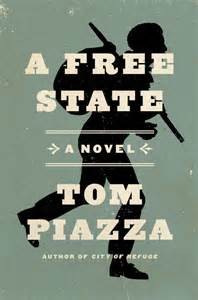 Tom Piazza’s third novel A Free State transports its readers to antebellum America, where a third-generation-Irish-immigrant farm boy and a black slave share more than their unsympathetic upbringings. Both young men are runaways who’ve traded harsh working conditions and brutal beatings to pursue their fascination with music. Their lives and stories intertwine through their participation in the minstrel tradition. A prolific writer on bluegrass, blues, and jazz, Piazza injects his prose with musical technique and terminology–so much so that his expertise may be lost on uninitiated readers. Still, it’s easy for any reader, musically inclined or not, to turn the pages of Piazza’s novel as quickly as a banjo player plucks his staccato strings. However, the entertaining melodies that carry A Free State serve as just another veneer covering up the harsh realities of minstrel shows’ roles in our cultural, political, and racial history.
Tom Piazza’s third novel A Free State transports its readers to antebellum America, where a third-generation-Irish-immigrant farm boy and a black slave share more than their unsympathetic upbringings. Both young men are runaways who’ve traded harsh working conditions and brutal beatings to pursue their fascination with music. Their lives and stories intertwine through their participation in the minstrel tradition. A prolific writer on bluegrass, blues, and jazz, Piazza injects his prose with musical technique and terminology–so much so that his expertise may be lost on uninitiated readers. Still, it’s easy for any reader, musically inclined or not, to turn the pages of Piazza’s novel as quickly as a banjo player plucks his staccato strings. However, the entertaining melodies that carry A Free State serve as just another veneer covering up the harsh realities of minstrel shows’ roles in our cultural, political, and racial history.
In 1855, nineteen-year-old slave Henry Sims escapes a Virginia plantation and establishes himself in Philadelphia. That same year, a musician from a minstrel troupe hears Henry’s excellent banjo playing and invites the street performer to join his act. Not only does James Douglass’ invitation violate the law in hosting a Negro performer on-stage, but it also violates the tradition of minstrelsy. Minstrel shows, in which white male performers dress in blackface to parody African-influenced song and dance, succeed in entertaining only because of their masks. In assuming blackface and contemporary Ebonics, minstrel acts permit white audiences to enjoy this style of music without accepting or condoning it. Henry nonetheless accepts, donning a “double masquerade” (54), and sets the ball rolling for a number of further complications.
Piazza is at his best when describing the music of the novel. Once the Douglass’ troupe begins to play, they’re all “angles, elbows, knees, bouncing” in rapturous performance, with “bones clicking and arms crisscrossing on and off the beat; the banjo and the fiddle neck and neck with one another as they line sang the familiar song” (126). Meanwhile, “a tidal wave” rolls through the crowd, “submerging the entire world under applause, screams, and hollers, a wall of sound almost physical in its force” (127). The dynamic energy that Piazza can give static text is remarkable. The sounds and rhythm and flow of his prose give life to the musicians and their instruments. Piazza also mixes colloquial descriptions with technical jargon in these scenes of performances. The characters, obviously very skillful musicians, become even more convincing to us as experts or professionals when they comment on the addition of a “perceptible increment of bravado” (127) to a tune or of “a compact fireworks display of triplets, staggered rhythms, reversed patterns” (134). Piazza occasionally gets carried away with detailed, though often metaphorical, descriptions that read more like step-by-step instructions for playing the banjo. He painstakingly illustrates a player “stroking down twice on a low string with his index fingernail, and then plucking once on the short, high string with his thumb, leaving the strings open” (134). Overall, however, Piazza’s poetic passion for music gets his readers stomping and clapping along with the beat and undoubtedly complicates their perception of the serious racism that the novel presents.
Piazza experiments with voice and perspective in creating parallel narratives, mainly of Douglass, Henry, and the bounty hunter Tull. While innovative at times, such as when he slips into a second-person-point of view in which the reader must put himself in a slaves’ shoes, his strategy also fails to tell an engaging story. One of Piazza’s most important perspectives—Douglass’—does more telling than showing. Piazza speeds through a superficial development of Douglass and Henry’s relationship, which would seem to be at the heart of his novel, but he scarcely describes their progression. For this reason, Henry has an unconvincing impact on Douglass by the end of the novel and his feelings of guilt and responsibility seem like polite afterthoughts, for the sake of appearances, rather than genuine emotions. By contrast, some of the most vivid scenes of any of the narratives describe Tull’s utterly evil and barbaric acts of violence. Piazza focuses too much on Tarantino-esque brutality rather than, for example, Douglass and Henry’s one-on-one practice sessions.
As the novel progresses, Piazza weaves these multi-perspective threads tighter and switches between them in quicker succession as they begin to overlap to form the novel’s climax. And it does not take long to get there; Piazza’s plot proceeds rather quickly. At certain turns, he attempts to create mystery and suspense, perhaps stalling his rapid pace, but he ultimately rushes through his straightforward narrative. In effect, the novel skimps on asking for commitment and engagement from the reader. At its conclusion, A Free State leaves the reader wanting more. Not more of the same writing, but more depth, more development, more characterization, more umph. Piazza introduces a unique slave narrative about the talented, eloquent runaway Henry, but the author’s unsatisfying execution does not provoke the emotional response expected from a tale about such hardship, brutality, and hope.
To the characters in A Free State, minstrel shows are a form of escape in antebellum America. Douglass left his family and his home to pursue his passion for music. Henry uses his banjo to create a whole new life for himself, away from his oppressive slave life on the plantation. But the nature of Henry’s disguise proves the more fragile. Set against a historical backdrop, the author comments on the troubling tradition of minstrel shows in our nation’s culture and our responsibility to remember and recall the horrific conditions of slavery. But when Piazza is not entertaining the audience with scenes of high-energy performances, he often underwhelms them with brisk and unsatisfying responses to issues of injustice, prejudice and hardship.

